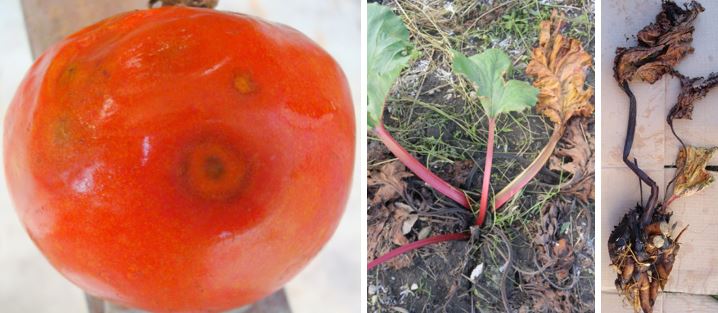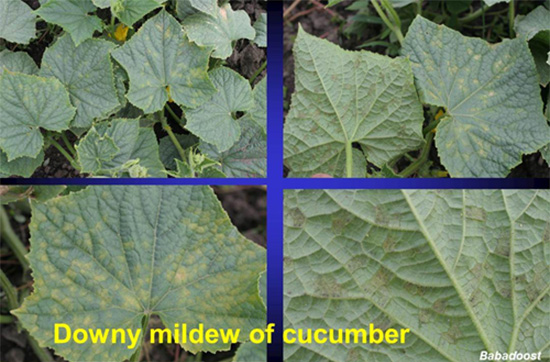"We are what we repeatedly do. Excellence, then, is not an act, but a habit." --Aristotle
Address any questions or comments regarding this newsletter to the individual authors listed after each article or to its editor, Rick Weinzierl, 217-333-6651, weinzier@illinois.edu. To receive e-mail notification of new postings of this newsletter, call or write the same number or address.
In This Issue:
Upcoming Programs (for beginning and established growers))
Regional Reports (from western and central Illinois ... notes on garlic, tomatoes, and rhubarb)
Vegetable Production and Pest Management (downy mildew of cucumbers)
Local Foods Issues (NRCS EQIP cut-off dates of November 21, 2014, and January 16, 2015)
Upcoming Programs
Check the Illinois SARE calendar for a full list of programs and links for registration.
http://illinoissare.org/ and http://illinoissare.org/calendar.php
Also see the University of Illinois Extension Local Food Systems and Small Farms Team's web site at:
http://web.extension.illinois.edu/smallfarm/ and their calendar of events at http://web.extension.illinois.edu/units/calendar.cfm?UnitID=629.
Illinois Specialty Crops, Agritourism, and Organics Conference, January 7-9, 2015, at the Crowne Plaza Hotel and Convention Center, Springfield, IL. See http://www.specialtygrowers.org/iscaoc-conference.html for the program ... scroll down to and click on the link that reads,
"Download 2015 Pre-Conference Program and Registration Form."
- Putting Small Acres to Work Workshop, November 1, 2014. 9:00 a.m. - 3:00 p.m., Sauk Valley Community College, Dixon. For more information and to register, see https://web.extension.illinois.edu/registration/?RegistrationID=10940
- Organic Gardening Day, November 1, 2014. 8:00 a.m. - 4:00 p.m., Urbana Plaza Hotel and Convention Center (formerly the Holiday Inn) in Urbana. For more information and to register, see http://web.extension.illinois.edu/units/event.cfm?UnitID=629&EventID=66842
- Working Towards a Thriving Year-Round Local Food System with High Tunnels Workshop, November 3, 2014. 1:00 - 4:00 p.m., Lincoln Land Community College - Workforce Careers Center, Springfield. For more information and to register, see https://web.extension.illinois.edu/registration/?RegistrationID=10896
- Good Ag Practices Workshop, November 11, 2014. 8:30 a.m. - 4:00 p.m., University of Illinois Extension Office, 1209 Wenthe Dr., Effingham. For more information and to register, see https://web.extension.illinois.edu/registration/?RegistrationID=11021
- 2014 Local and Regional Food Summit, November 13, 2014. 9:00 a.m. - 5:00 p.m., Heartland Community College, Astroth Community Education Center, 1500 West Raab Road, Normal, IL. Hosted by the Illinois Farm Bureau, Illinois Department of Agriculture and Heartland Community College. Conference registration fee is $20 per participant and includes all conference materials, lunch, and breaks. Register at http://www.ilfb.org/ifb-news-and-events/conferences-events/2014-local-and-regional-food-summit.aspx. Speakers will include industries such as retail grocery, foodservice distribution, university foodservice, food hub, energy alternatives, specialty crops, meat processing, dairy, value-added products, community supported agriculture and more. Register in advance; space is limited. A special Meet the Farmer/Meet the Buyer event for farmers and buyers will take place between 3:15 pm and 5:00 pm for farmers attending the Summit.
Regional Reports
From western Illinois ... Timing for garlic planting ... As with any fruit and vegetable production decision, the answer to, "When should I plant garlic?" varies. As a general rule, planting garlic in the fall, six weeks before the ground freezes is most likely to the "best" time. The goal is to plant early enough that the plant establishes a healthy root system yet limit the growth of tender green top growth. The window will vary based on fall conditions and locations in the state. The further north we go, the earlier it should go in the ground. Southern Illinois growers have more of an extended window. Last year proved that garlic is a resilient plant. Much of the garlic that was planted went in "late," but the subsequent crop did not seem to be negatively affected. On my farm in west-central Illinois, I did not get garlic planted until Thanksgiving weekend. As the harsh winter progressed I had little hope that I would see an average crop. I was proven wrong, as I harvested one of the best crops I have grown. That is not to say this would always happen, but it does indicate that the crop can withstand some less-than-optimal conditions and still do well.
Kyle Cecil (309-342-5108; cecil@illinois.edu)
From (the northeastern part of ) central Illinois ... On a flat, rather poorly-drained planting in Livingstone County, I recently observed two rather too common late-season diseases of tomato and rhubarb.
On tomatoes, water-soaked lesions loaded with fruiting bodies (conidia), consistent with anthracnose (Colletotrichum sp.) disease, were common on ripe and on over-ripe tomatoes. In outdoor production at this time of year, this disease is common, and tomato harvest is over or all-but-over anyway. To prevent or delay the onset of this disease next year, mulch tomato plants to prevent splash dispersal of fungal inoculum, trellis the plants so fruit will be far from the ground, use resistant varieties, and rotate with non-solanaceous crops. Harvesting tomatoes before they are fully ripe avoids some infections and loses. Fungicides recommended for control of anthracnose are listed in the 2014 Midwest Vegetable Production Guide.

Left: anthracnose of tomato. Center and right: crown rot of rhubarb. (Center photo by C. Edwards)
On rhubarb, leaves and stalks were at various stages of withering. A further check revealed that roots were healthy, and rotting was only in the crown region. A crown rot disease does occur late in the season on rhubarb growing in poorly drained soils, and the area's wet September and October were favorable for disease development.
A group of soil-inhabiting fungi is involved in crown rot disease, and those fungi can include Phytophthora spp. Crown rot of rhubarb is best controlled by propagating with disease-free material and growing on well drained sites. Diseased plants should be dug and discarded, and a 3-year rotation plan should be used.
James Theuri (815-933-8337; jtheu50@illinois.edu)
Vegetable Production and Pest Management
Cucumber Downy Mildew
(Editor's note: Dr. Babadoost provided this update before the September 15 issue of this newsletter was published, but the article was inadvertently left out of that issue.)
I detected downy mildew in a cucumber field in Arcola (Douglas County, Illinois) on September 5, 2014. This was the first report of downy mildew of cucurbits in Illinois in 2014. Downy mildew of cucurbits, caused by the oomycete Pseudoperonospora cubensis, is a very destructive disease. Based on available information, the pathogen that causes downy mildew of cucurbits does not overwinter in Illinois; it is blown to Illinois from the southern United States or brought in on plant material such as transplants. Downy mildew is favored by cool temperatures (59 to 68 degrees F) and leaf wetness.
Downy mildew affects leaves only. The first symptom is usually the appearance of indistinct, pale green areas on the upper leaf surface. The pale green areas soon become yellow in color and angular to irregular in shape, bounded by the leaf veins. As the disease progress the lesions may remain yellow or become brown and necrotic. During moist weather the corresponding lower leaf surface is covered with a downy, pale gray to purple mildew. Often an upward leaf curling will occur (see photos).
Several fungicides have been labeled for control of downy mildew of cucurbits, including products with the active ingredient phosphorus acid (Agri-Fos, Phostrol, and ProPhyt), Curzate, Forum, Gavel, Presidio, Previcur Flex, Ranman, Revus, Tanos, and Zampro. In the experimental plots in Illinois, sprays of Revus + Bravo Weather Stik (BWS) alternated with Ranman + BWS, Tanos + BWS, Gavel + BWS, or Zampro + BWS have been effective for control of downy mildew.

Mohammad Babadoost (217-333-1523; babadoos@illinois.edu)
Local Foods Issues
EQIP Application Deadlines (for high tunnel and other assistance)
The Environmental Quality Incentives Program (EQIP) is a voluntary program that provides financial and technical assistance to agricultural producers through contracts. These contracts provide financial assistance for producers to address soil, water, and related natural resource concerns on private agricultural land and non-industrial private forestland. In addition, a purpose of EQIP is to help producers meet Federal, State, Tribal and local environmental regulations. Throughout Illinois, producers have received assistance to implement conservation practices that include, but are not limited to, nutrient management, cover crops, terraces, grassed waterways, manure management facilities, and pasture management. For fruit and vegetable growers, high tunnel programs and pollinator habitat programs may be especially relevant. Applications for EQIP are accepted on a continuous basis; however Illinois NRCS has established two application cutoff dates: November 21, 2014, and January 16, 2015. See http://www.nrcs.usda.gov/wps/portal/nrcs/detail/il/programs/financial/eqip/?cid=nrcs141p2_030467.
Mary Hosier (217-333-7512; mhosier@illinois.edu)
University of Illinois Extension Specialists in Fruit and Vegetable Production & Pest Management
Extension Educators – Local Food Systems and Small Farms |
||
Bronwyn Aly, Gallatin, Hamilton, Hardin, Pope, Saline, and White counties |
618-382-2662 |
|
Katie Bell, Franklin, Jackson, Perry, Randolph, & Williamson counties |
618-687-1727 |
|
Sarah Farley, Lake & McHenry counties |
847-223-8627 |
|
Nick Frillman, Woodford, Livingston, & McLean counties |
309-663-8306 |
|
Laurie George, Bond, Clinton, Jefferson, Marion, & Washington counties |
618-548-1446 |
|
Zachary Grant, Cook County | 708-679-6889 | |
Doug Gucker, DeWitt, Macon, and Piatt counties |
217-877-6042 |
|
Erin Harper, Champaign, Ford, Iroquois, and Vermillion counties |
217-333-7672 |
|
Grace Margherio, Jackie Joyner-Kersee Center, St. Clair County |
217-244-3547 |
|
Grant McCarty, Jo Daviess, Stephenson, and Winnebago counties |
815-235-4125 |
|
Katie Parker, Adams, Brown, Hancock, Pike and Schuyler counties |
217-223-8380 |
|
Kathryn Pereira, Cook County |
773-233-2900 |
|
James Theuri, Grundy, Kankakee, and Will counties |
815-933-8337 |
|
Extension Educators – Horticulture |
||
Chris Enroth, Henderson, Knox, McDonough, and Warren counties |
309-837-3939 |
|
Richard Hentschel, DuPage, Kane, and Kendall counties |
630-584-6166 |
|
Andrew Holsinger, Christian, Jersey, Macoupin, & Montgomery counties |
217-532-3941 |
|
Extension Educators - Commercial Agriculture |
||
Elizabeth Wahle, Fruit & Vegetable Production |
618-344-4230 |
|
Nathan Johanning, Madison, Monroe & St. Clair counties |
618-939-3434 |
|
Campus-based Extension Specialists |
||
Kacie Athey, Entomology |
217-244-9916 |
|
Mohammad Babadoost, Plant Pathology |
217-333-1523 |
|